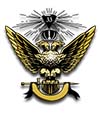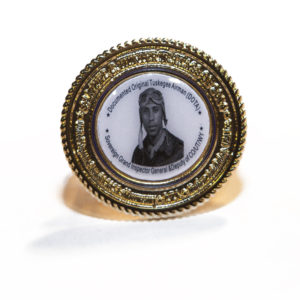ABOUT SAMUEL C. HUNTER JR.
B-25 pilot and Documented Original Tuskegee Airman (DOTA) Samuel Crockett Hunter, Jr. was born in Crockett, Texas in 1919, and brought to Colorado Springs in 1920 on a visit with his parents who then made a decision to stay, anticipating Colorado might provide better opportunities than Texas had to offer blacks one generation removed from slavery. His adult life was shaped by the Tuskegee experience and was focused on fighting for equal opportunities for minorities in housing, employment and education.
- Education
Hunter attended Lowell Elementary, South Junior High and graduated from Colorado Springs High School (now William J. Palmer) in 1936. He followed friends he met in Denver playing in a basketball league, to West Virginia State College in Institute, WV, a historically black college at the time. Hunter earned a Bachelor of Science Degree in Business Administration in 1940. While attending West Virginia State, he noted many of the campus leaders belonged to the Omega Psi Phi fraternity thus motivating him to become a member. He served as the editor for the Theta Psi Chapter his junior year. He also played forward on the WV State basketball team. One of Hunter’s fraternity brothers was George S. “Spanky” Roberts, who later became commander of the 99th Fighter Squadron and 332nd Fighter Group of the Tuskegee Airmen. Roberts tried to recruit Hunter to train for an instructor’s rating in the Civilian Pilot Training Program (CPTP) at West Virginia State College. However Hunter’s father was establishing a mortician’s business in Colorado Springs so Hunter chose instead to continue his education, graduating from the Worsham College of Mortuary Science in Chicago, Illinois in 1941.
Civilian Pilot Training and Tuskegee Airman Experience
After the attack on Pearl Harbor, WWII conscription required men 18 to 64 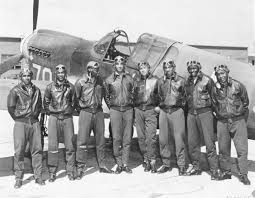 years of age to register and if drafted, their service would extend through the end of the war. This led Hunter to reconsider the Civilian Pilot Training Program. He enlisted in the US Army in 1942 and entered the CPT Program at the Coffey School of Aeronautics at Harlem Airfield in Chicago to secure an Instructor’s Rating for flying. His training at Coffey included the Piper Cub, a 220 Waco twin-engine 220 horsepower biplane. Hunter obtained a civilian pilot’s license but was unable to secure an instructor’s position after the CPT programs at the historically black schools were consolidated and moved to Tuskegee, Alabama. With the consolidation, black instructors were no longer permitted. In 1943 Hunter was assigned to Basic Training in Greensboro, NC where he took the BNP test (bombardier, navigator, and pilot). Having a pilot’s license and being under the age of 26 helped Hunter enroll as a cadet pilot at Tuskegee. Hunter’s training at Moton Field included the Stearman PT-17 and the Vultee (or Vulcan or Vibrator) BT-13. Cadets were separated by height; shorter pilots went to single-engine training and taller pilots to twin-engine training. Hunter being 6’1” was assigned to twin-engine training in the AT-10 and later the B-25.
years of age to register and if drafted, their service would extend through the end of the war. This led Hunter to reconsider the Civilian Pilot Training Program. He enlisted in the US Army in 1942 and entered the CPT Program at the Coffey School of Aeronautics at Harlem Airfield in Chicago to secure an Instructor’s Rating for flying. His training at Coffey included the Piper Cub, a 220 Waco twin-engine 220 horsepower biplane. Hunter obtained a civilian pilot’s license but was unable to secure an instructor’s position after the CPT programs at the historically black schools were consolidated and moved to Tuskegee, Alabama. With the consolidation, black instructors were no longer permitted. In 1943 Hunter was assigned to Basic Training in Greensboro, NC where he took the BNP test (bombardier, navigator, and pilot). Having a pilot’s license and being under the age of 26 helped Hunter enroll as a cadet pilot at Tuskegee. Hunter’s training at Moton Field included the Stearman PT-17 and the Vultee (or Vulcan or Vibrator) BT-13. Cadets were separated by height; shorter pilots went to single-engine training and taller pilots to twin-engine training. Hunter being 6’1” was assigned to twin-engine training in the AT-10 and later the B-25.
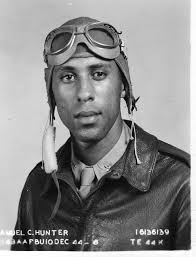 Hunter was cadet captain of his class and graduated in the class of 44-J as a 2nd Lt. B-25 pilot. He was assigned to the 616th Bombardment Squad, 477th Bombardment Group, at Godman Field, KY, in December of 1944. The Japanese surrendered before the 477th could be deployed. Hunter separated from the United States Army Air Force in November 1945, with a commercial pilot license and received an honorable discharge as Captain from the USAF Reserves on September 9, 1959.
Hunter was cadet captain of his class and graduated in the class of 44-J as a 2nd Lt. B-25 pilot. He was assigned to the 616th Bombardment Squad, 477th Bombardment Group, at Godman Field, KY, in December of 1944. The Japanese surrendered before the 477th could be deployed. Hunter separated from the United States Army Air Force in November 1945, with a commercial pilot license and received an honorable discharge as Captain from the USAF Reserves on September 9, 1959.
Tuskegee Airmen, Inc. was organized in 1972 and many Documented Original Tuskegee Airmen (DOTAs) joined together to encourage and promote more African-American and youth participation in aerospace, aviation, engineering, and math and careers. Hunter attended national conventions of the Tuskegee Airmen, Inc, and actively participated in the Colorado chapter named in honor of Hubert L. Hooks Jones. Hunter was a frequent speaker on programs during Black History month in February and 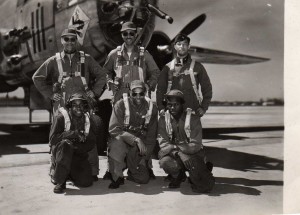 was involved in establishing the statue sculpted by DOTA Clarence Shivers, honoring Tuskegee Airmen on the grounds of the US Air Force Academy. Hunter and his fellow DOTAs were awarded the Congressional Gold Medal in 2007 and recognized in the June 11, 2007 Congressional Record. Hunter did not attend the ceremony in 2007, however he did accept the invitation and attended the Inauguration of President Barack Obama, with fellow DOTAs, on January 20, 2009.
was involved in establishing the statue sculpted by DOTA Clarence Shivers, honoring Tuskegee Airmen on the grounds of the US Air Force Academy. Hunter and his fellow DOTAs were awarded the Congressional Gold Medal in 2007 and recognized in the June 11, 2007 Congressional Record. Hunter did not attend the ceremony in 2007, however he did accept the invitation and attended the Inauguration of President Barack Obama, with fellow DOTAs, on January 20, 2009.
ABOUT SAMUEL C. HUNTER JR.
Business and Civic Life
No commercial pilot opportunities were available to blacks after the war. Hunter returned to Colorado Springs to assist his father and then later direct the operation of Hunter Mortuary. Hunter also became the first black real estate broker in Colorado Springs and opened Hunter & Co. Real Estate in 1959, which remained open until his semi-retirement in 2001. Hunter’s interest in real estate was linked to limited opportunities for blacks to purchase homes in Colorado Springs. Hunter also pioneered multi-family housing for minorities by developing the Payne Chapel Housing program and was chairman of the board when Prince Hall Housing was implemented.
Hunter’s civic and organizational life focused on minority inclusion and fairness in business and education. As a result he received numerous awards, acknowledgements and citations, including the 2005 Colorado College Diversity Award as an advocate for equality in housing and contributions to the community, business, education and civic activities of Colorado Springs. In 2004 he received the NAACP Living Legends Award for Civil Rights Activism in the Colorado Springs community. Hunter was a member of the original Head Start Board, the Colorado Springs Park & Recreation Board, the Golf Commission, and the Board of Directors of the Colorado Springs Board of REALTORS. He was past president and life member of the local NAACP, past president of the local Urban League, and a former member of the Colorado Springs Urban Renewal Authority. He also tutored in reading programs for elementary school students.
Hunter believed and lived the principles of Freemasonry. He was initiated in Pikes Peak Lodge No. 5 in 1948, and served as Worshipful Master in 1961, 1962 and 1966. He became a 32nd degree Mason in 1948 in Mountain and Plains Consistory No. 33, Ancient and Accepted Scottish Rite of Freemasonry, Prince Hall Affiliation Northern Jurisdiction, U.S.A., Inc. Hunter became a 33rd degree Mason in 1969. He was elected and served as Most Worshipful Grand Master 1969 -1971, becoming the first son to follow his father as Grand Master of the Colorado jurisdiction. Hunter was Active Sovereign Grand Inspector General in 1971 and appointed Deputy of the Orient of Colorado & Utah, Ancient and Accepted Scottish Rite of Freemasonry, Prince Hall Affiliation Northern Jurisdiction, U.S.A., Inc., actively serving until his passing in December 2013. The 33rd Degree Mason class of the United Supreme Council, Northern Jurisdiction was named the Samuel C. Hunter, Jr. Class of 2014.
Hunter was a charter member of the Xi Pi Chapter of Omega Psi Phi Fraternity. Hunter was also a lifetime member and Trustee Emeritus of Payne Chapel A.M.E. Church.
Family
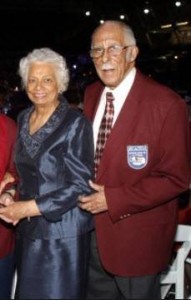 Hunter married Minnie Ray Lane in 1950. Their union resulted in three children, two grandchildren and three great-grandchildren. Being the owner of a small business, Hunter worked long hours. His wife was his partner in life and in business, working as the office manager, and all of the children were employed during the summers. One daughter was also employed in the family business early in her working career.
Hunter married Minnie Ray Lane in 1950. Their union resulted in three children, two grandchildren and three great-grandchildren. Being the owner of a small business, Hunter worked long hours. His wife was his partner in life and in business, working as the office manager, and all of the children were employed during the summers. One daughter was also employed in the family business early in her working career.
Hunter taught his children how to live by his example. He practiced what he preached, providing them with a path to be responsible for their own actions and decisions. Standards for their behavior focused on how to treat people and following one hard and fast rule of church attendance every Sunday. Hunter seldom raised his voice in anger. He didn’t hold grudges. He didn’t judge or try to control others. He was honest and fair. He was inclusive in his respect for all people. He was loyal and made commitments built to last – a lifelong member of the same church, 63 years of marriage, and 70+ years of active engagement in his community and fraternal organizations.
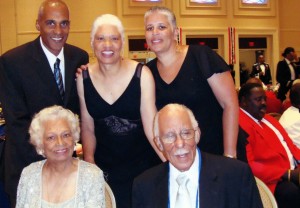 Hunter loved Colorado weather, especially the sunshine. In his retirement he took every opportunity to eat breakfast outdoors. He derived great joy from his grandchildren and great-grandchildren. Of the numerous awards, plaques and tributes paid to Hunter, one of his most cherished was the naming of his third great-grandson – Samuel. The longevity of his honorable life was truly a blessing for his family.
Hunter loved Colorado weather, especially the sunshine. In his retirement he took every opportunity to eat breakfast outdoors. He derived great joy from his grandchildren and great-grandchildren. Of the numerous awards, plaques and tributes paid to Hunter, one of his most cherished was the naming of his third great-grandson – Samuel. The longevity of his honorable life was truly a blessing for his family.
